Cloud Computing Implementation for Carmen's Fine Food: A Report
VerifiedAdded on 2022/12/29
|17
|4290
|1
Report
AI Summary
This report details the introduction of cloud computing into business operations, focusing on the case of Carmen's Fine Food. It begins with an assessment of current computing resources and future needs, followed by a review of business requirements. The report delves into the fundamentals of cloud computing, including various service models (SaaS, PaaS, IaaS), and identifies specialist advisors for cloud services. A comprehensive cost-benefit analysis is conducted, outlining both the costs and advantages of cloud adoption. The report also explores potential opportunities and risks associated with cloud computing and formulates a business case, including steps for approval. The implementation plan includes short and long-term goals, budget formulation, and steps for introducing cloud computing, culminating in an implementation strategy and training recommendations to maximize the potential of cloud computing within the organization. The report also contains references.
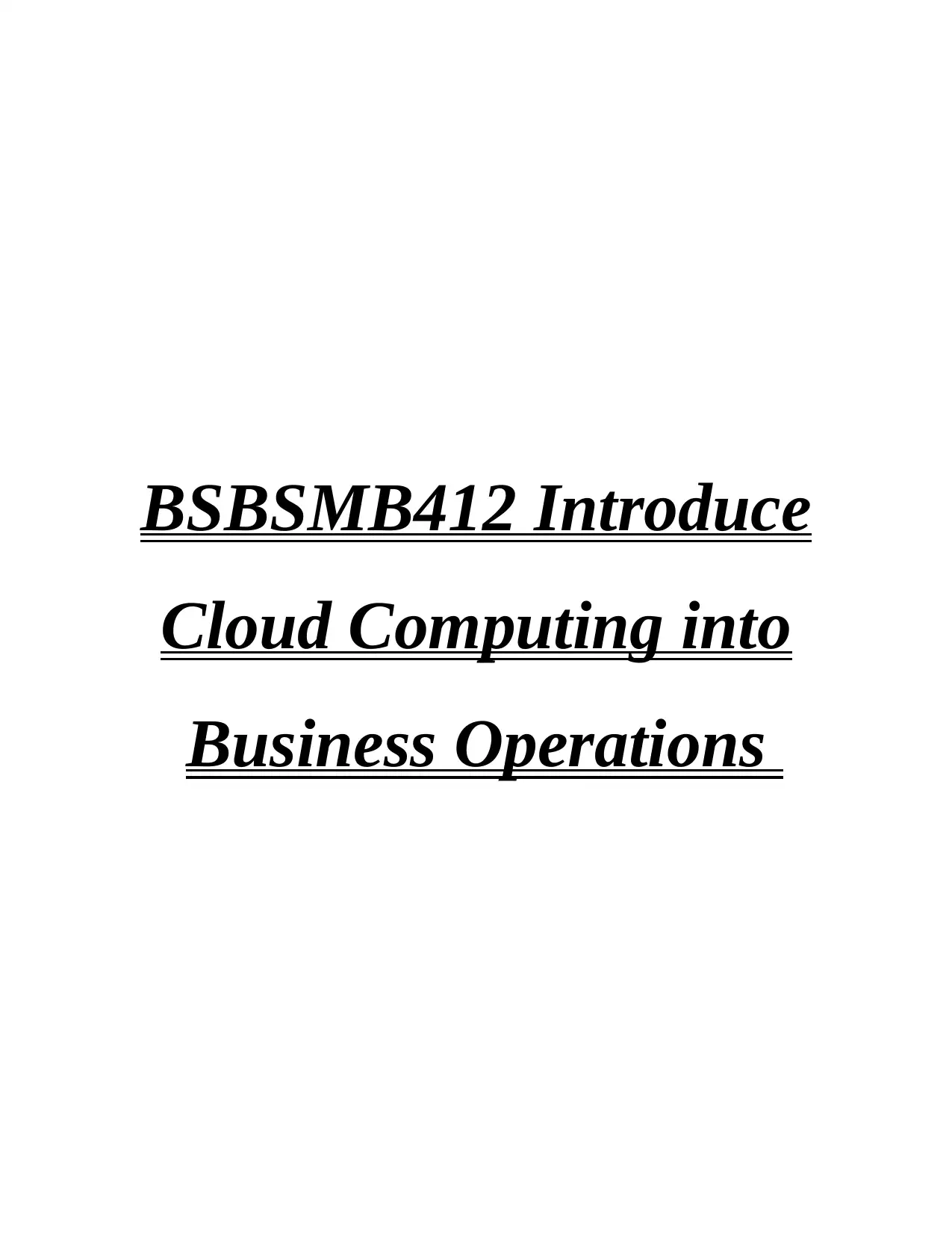
BSBSMB412 Introduce
Cloud Computing into
Business Operations
Cloud Computing into
Business Operations
Paraphrase This Document
Need a fresh take? Get an instant paraphrase of this document with our AI Paraphraser
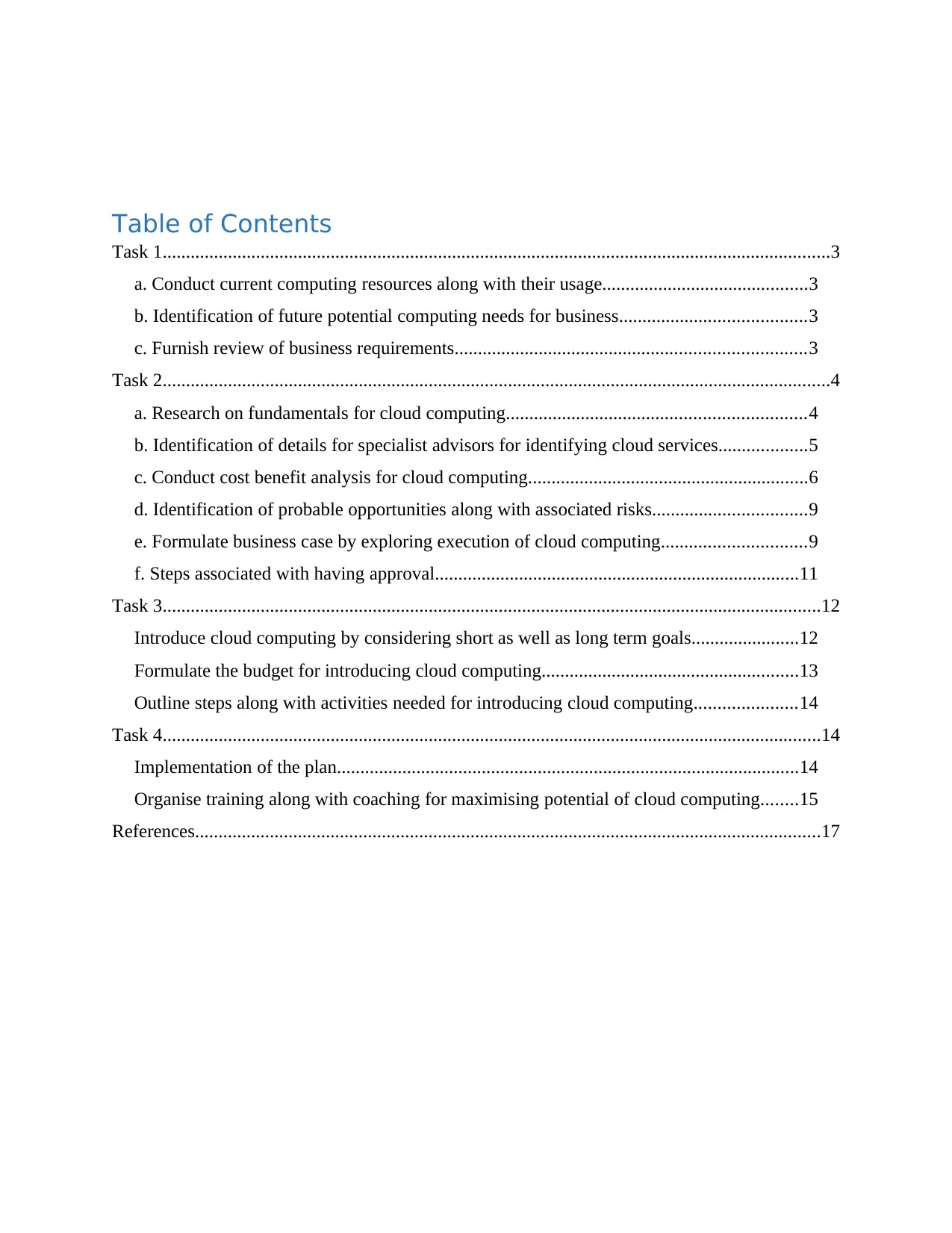
Table of Contents
Task 1...............................................................................................................................................3
a. Conduct current computing resources along with their usage............................................3
b. Identification of future potential computing needs for business........................................3
c. Furnish review of business requirements...........................................................................3
Task 2...............................................................................................................................................4
a. Research on fundamentals for cloud computing................................................................4
b. Identification of details for specialist advisors for identifying cloud services...................5
c. Conduct cost benefit analysis for cloud computing............................................................6
d. Identification of probable opportunities along with associated risks.................................9
e. Formulate business case by exploring execution of cloud computing...............................9
f. Steps associated with having approval..............................................................................11
Task 3.............................................................................................................................................12
Introduce cloud computing by considering short as well as long term goals.......................12
Formulate the budget for introducing cloud computing.......................................................13
Outline steps along with activities needed for introducing cloud computing......................14
Task 4.............................................................................................................................................14
Implementation of the plan...................................................................................................14
Organise training along with coaching for maximising potential of cloud computing........15
References......................................................................................................................................17
Task 1...............................................................................................................................................3
a. Conduct current computing resources along with their usage............................................3
b. Identification of future potential computing needs for business........................................3
c. Furnish review of business requirements...........................................................................3
Task 2...............................................................................................................................................4
a. Research on fundamentals for cloud computing................................................................4
b. Identification of details for specialist advisors for identifying cloud services...................5
c. Conduct cost benefit analysis for cloud computing............................................................6
d. Identification of probable opportunities along with associated risks.................................9
e. Formulate business case by exploring execution of cloud computing...............................9
f. Steps associated with having approval..............................................................................11
Task 3.............................................................................................................................................12
Introduce cloud computing by considering short as well as long term goals.......................12
Formulate the budget for introducing cloud computing.......................................................13
Outline steps along with activities needed for introducing cloud computing......................14
Task 4.............................................................................................................................................14
Implementation of the plan...................................................................................................14
Organise training along with coaching for maximising potential of cloud computing........15
References......................................................................................................................................17
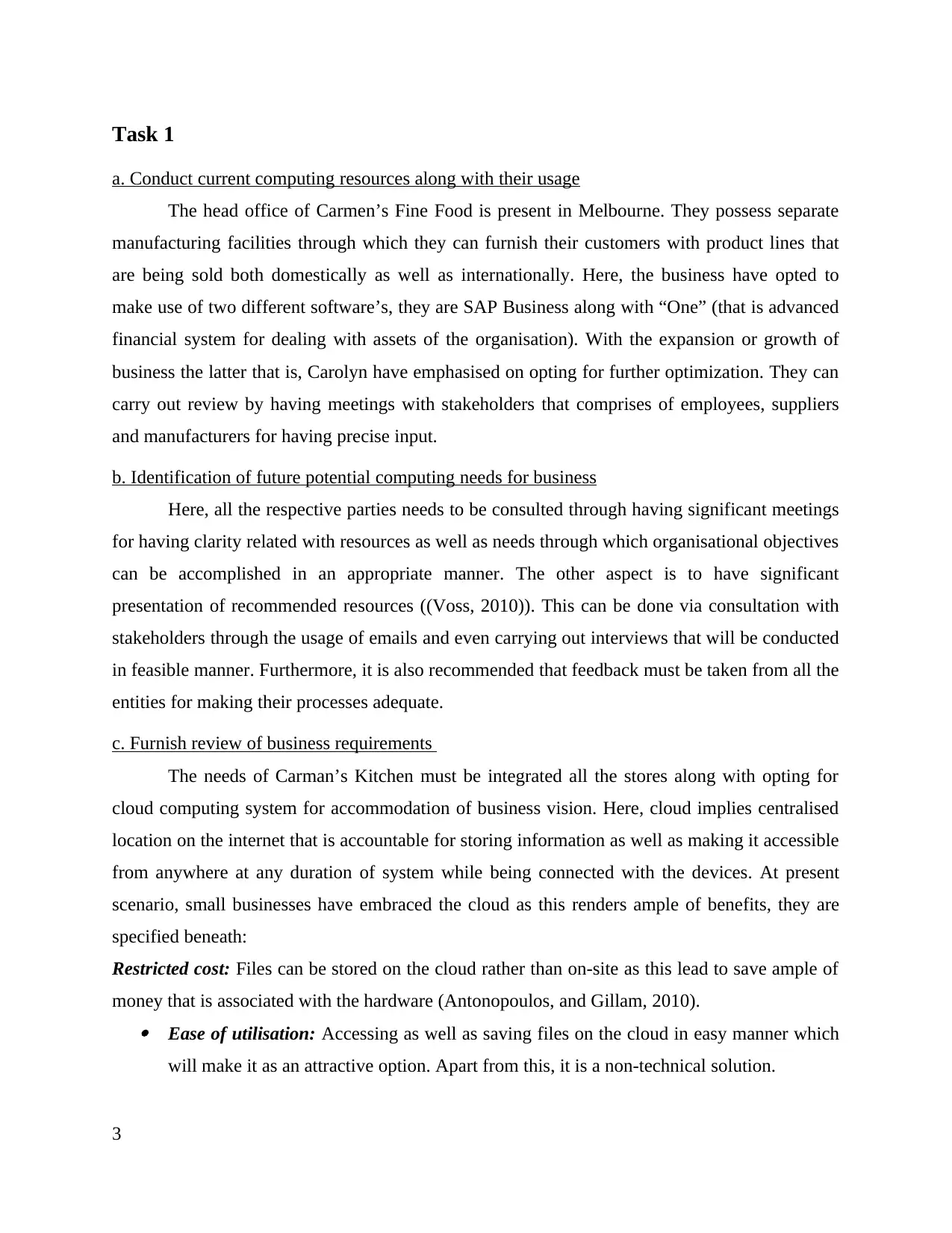
Task 1
a. Conduct current computing resources along with their usage
The head office of Carmen’s Fine Food is present in Melbourne. They possess separate
manufacturing facilities through which they can furnish their customers with product lines that
are being sold both domestically as well as internationally. Here, the business have opted to
make use of two different software’s, they are SAP Business along with “One” (that is advanced
financial system for dealing with assets of the organisation). With the expansion or growth of
business the latter that is, Carolyn have emphasised on opting for further optimization. They can
carry out review by having meetings with stakeholders that comprises of employees, suppliers
and manufacturers for having precise input.
b. Identification of future potential computing needs for business
Here, all the respective parties needs to be consulted through having significant meetings
for having clarity related with resources as well as needs through which organisational objectives
can be accomplished in an appropriate manner. The other aspect is to have significant
presentation of recommended resources ((Voss, 2010)). This can be done via consultation with
stakeholders through the usage of emails and even carrying out interviews that will be conducted
in feasible manner. Furthermore, it is also recommended that feedback must be taken from all the
entities for making their processes adequate.
c. Furnish review of business requirements
The needs of Carman’s Kitchen must be integrated all the stores along with opting for
cloud computing system for accommodation of business vision. Here, cloud implies centralised
location on the internet that is accountable for storing information as well as making it accessible
from anywhere at any duration of system while being connected with the devices. At present
scenario, small businesses have embraced the cloud as this renders ample of benefits, they are
specified beneath:
Restricted cost: Files can be stored on the cloud rather than on-site as this lead to save ample of
money that is associated with the hardware (Antonopoulos, and Gillam, 2010). Ease of utilisation: Accessing as well as saving files on the cloud in easy manner which
will make it as an attractive option. Apart from this, it is a non-technical solution.
3
a. Conduct current computing resources along with their usage
The head office of Carmen’s Fine Food is present in Melbourne. They possess separate
manufacturing facilities through which they can furnish their customers with product lines that
are being sold both domestically as well as internationally. Here, the business have opted to
make use of two different software’s, they are SAP Business along with “One” (that is advanced
financial system for dealing with assets of the organisation). With the expansion or growth of
business the latter that is, Carolyn have emphasised on opting for further optimization. They can
carry out review by having meetings with stakeholders that comprises of employees, suppliers
and manufacturers for having precise input.
b. Identification of future potential computing needs for business
Here, all the respective parties needs to be consulted through having significant meetings
for having clarity related with resources as well as needs through which organisational objectives
can be accomplished in an appropriate manner. The other aspect is to have significant
presentation of recommended resources ((Voss, 2010)). This can be done via consultation with
stakeholders through the usage of emails and even carrying out interviews that will be conducted
in feasible manner. Furthermore, it is also recommended that feedback must be taken from all the
entities for making their processes adequate.
c. Furnish review of business requirements
The needs of Carman’s Kitchen must be integrated all the stores along with opting for
cloud computing system for accommodation of business vision. Here, cloud implies centralised
location on the internet that is accountable for storing information as well as making it accessible
from anywhere at any duration of system while being connected with the devices. At present
scenario, small businesses have embraced the cloud as this renders ample of benefits, they are
specified beneath:
Restricted cost: Files can be stored on the cloud rather than on-site as this lead to save ample of
money that is associated with the hardware (Antonopoulos, and Gillam, 2010). Ease of utilisation: Accessing as well as saving files on the cloud in easy manner which
will make it as an attractive option. Apart from this, it is a non-technical solution.
3
⊘ This is a preview!⊘
Do you want full access?
Subscribe today to unlock all pages.

Trusted by 1+ million students worldwide
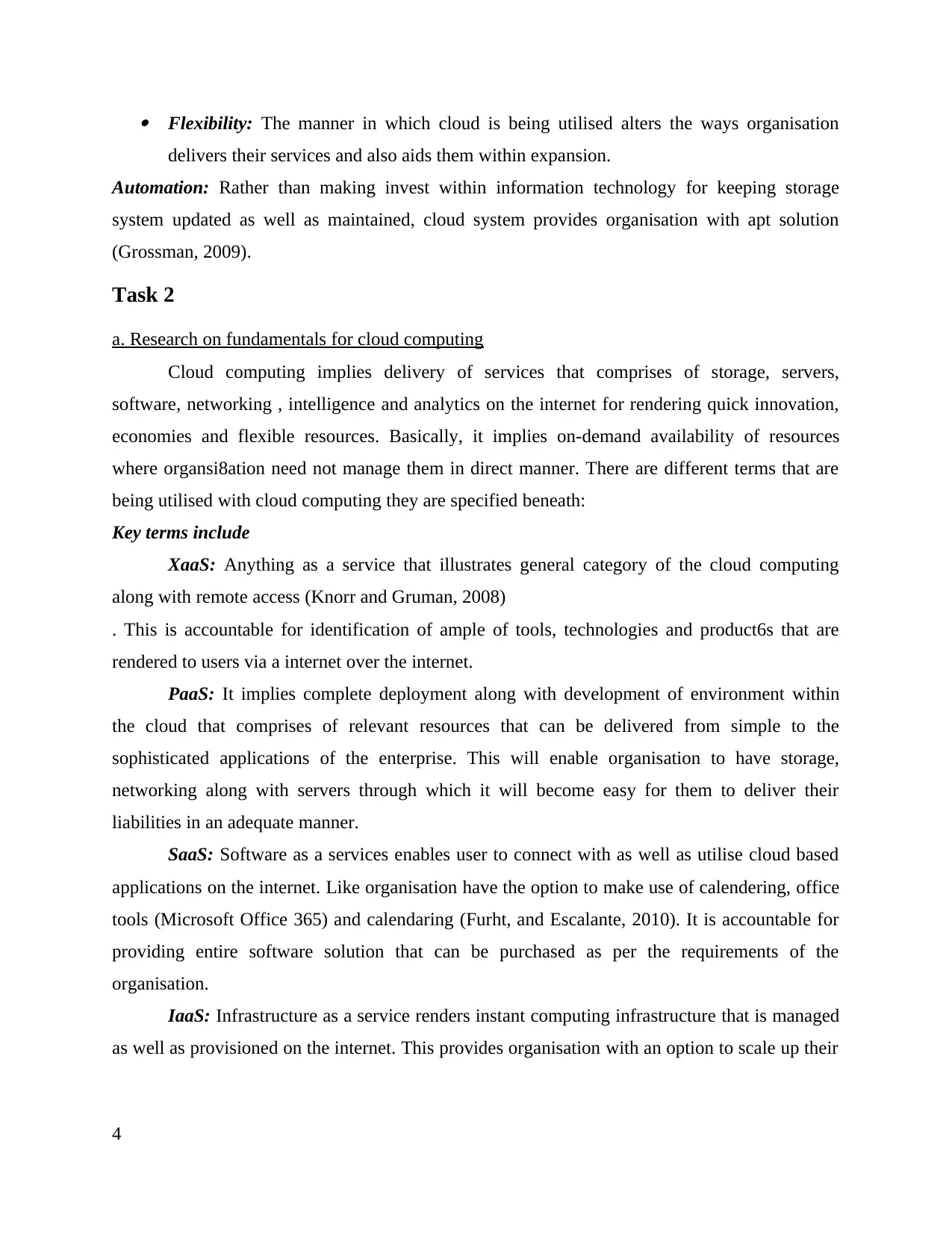
Flexibility: The manner in which cloud is being utilised alters the ways organisation
delivers their services and also aids them within expansion.
Automation: Rather than making invest within information technology for keeping storage
system updated as well as maintained, cloud system provides organisation with apt solution
(Grossman, 2009).
Task 2
a. Research on fundamentals for cloud computing
Cloud computing implies delivery of services that comprises of storage, servers,
software, networking , intelligence and analytics on the internet for rendering quick innovation,
economies and flexible resources. Basically, it implies on-demand availability of resources
where organsi8ation need not manage them in direct manner. There are different terms that are
being utilised with cloud computing they are specified beneath:
Key terms include
XaaS: Anything as a service that illustrates general category of the cloud computing
along with remote access (Knorr and Gruman, 2008)
. This is accountable for identification of ample of tools, technologies and product6s that are
rendered to users via a internet over the internet.
PaaS: It implies complete deployment along with development of environment within
the cloud that comprises of relevant resources that can be delivered from simple to the
sophisticated applications of the enterprise. This will enable organisation to have storage,
networking along with servers through which it will become easy for them to deliver their
liabilities in an adequate manner.
SaaS: Software as a services enables user to connect with as well as utilise cloud based
applications on the internet. Like organisation have the option to make use of calendering, office
tools (Microsoft Office 365) and calendaring (Furht, and Escalante, 2010). It is accountable for
providing entire software solution that can be purchased as per the requirements of the
organisation.
IaaS: Infrastructure as a service renders instant computing infrastructure that is managed
as well as provisioned on the internet. This provides organisation with an option to scale up their
4
delivers their services and also aids them within expansion.
Automation: Rather than making invest within information technology for keeping storage
system updated as well as maintained, cloud system provides organisation with apt solution
(Grossman, 2009).
Task 2
a. Research on fundamentals for cloud computing
Cloud computing implies delivery of services that comprises of storage, servers,
software, networking , intelligence and analytics on the internet for rendering quick innovation,
economies and flexible resources. Basically, it implies on-demand availability of resources
where organsi8ation need not manage them in direct manner. There are different terms that are
being utilised with cloud computing they are specified beneath:
Key terms include
XaaS: Anything as a service that illustrates general category of the cloud computing
along with remote access (Knorr and Gruman, 2008)
. This is accountable for identification of ample of tools, technologies and product6s that are
rendered to users via a internet over the internet.
PaaS: It implies complete deployment along with development of environment within
the cloud that comprises of relevant resources that can be delivered from simple to the
sophisticated applications of the enterprise. This will enable organisation to have storage,
networking along with servers through which it will become easy for them to deliver their
liabilities in an adequate manner.
SaaS: Software as a services enables user to connect with as well as utilise cloud based
applications on the internet. Like organisation have the option to make use of calendering, office
tools (Microsoft Office 365) and calendaring (Furht, and Escalante, 2010). It is accountable for
providing entire software solution that can be purchased as per the requirements of the
organisation.
IaaS: Infrastructure as a service renders instant computing infrastructure that is managed
as well as provisioned on the internet. This provides organisation with an option to scale up their
4
Paraphrase This Document
Need a fresh take? Get an instant paraphrase of this document with our AI Paraphraser
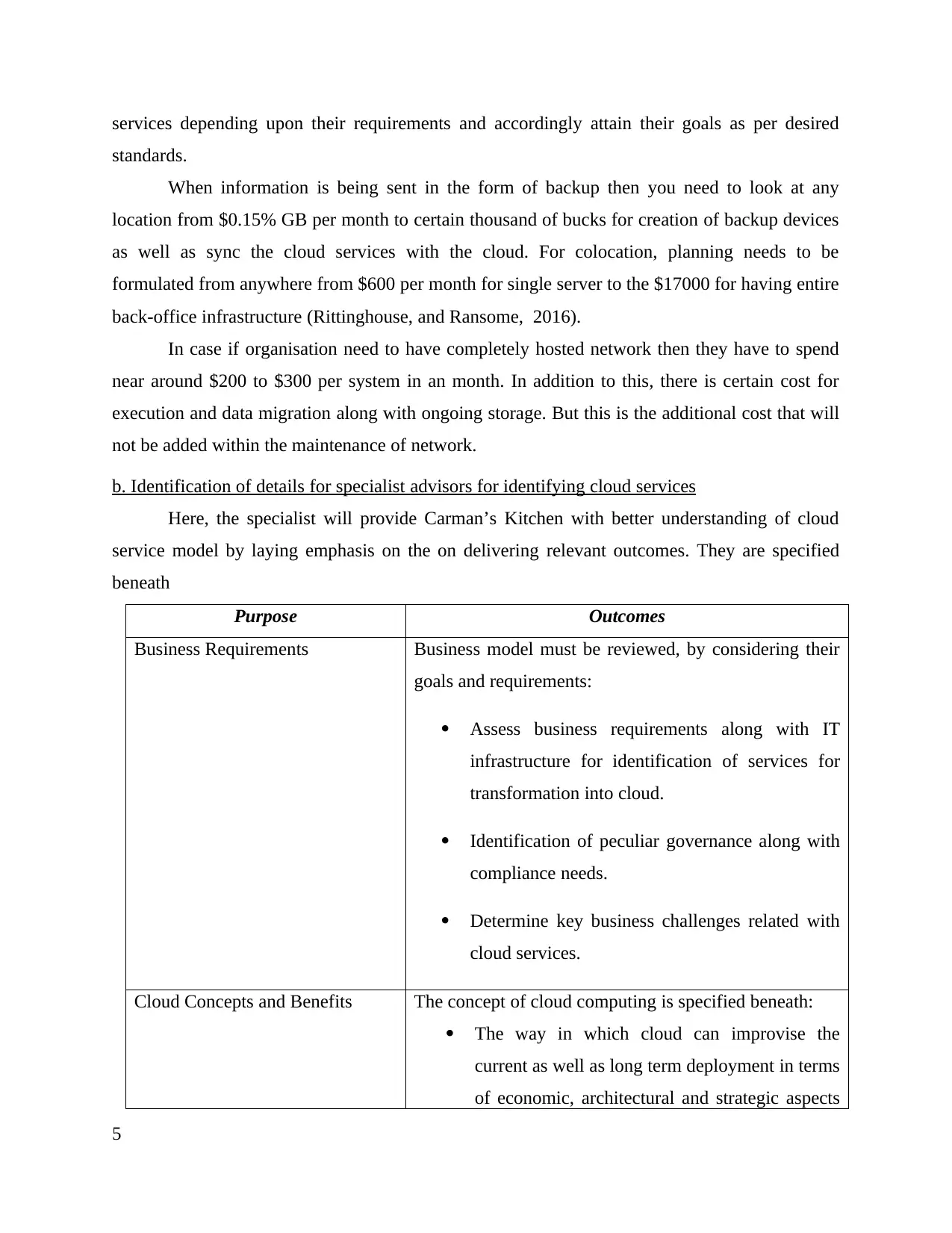
services depending upon their requirements and accordingly attain their goals as per desired
standards.
When information is being sent in the form of backup then you need to look at any
location from $0.15% GB per month to certain thousand of bucks for creation of backup devices
as well as sync the cloud services with the cloud. For colocation, planning needs to be
formulated from anywhere from $600 per month for single server to the $17000 for having entire
back-office infrastructure (Rittinghouse, and Ransome, 2016).
In case if organisation need to have completely hosted network then they have to spend
near around $200 to $300 per system in an month. In addition to this, there is certain cost for
execution and data migration along with ongoing storage. But this is the additional cost that will
not be added within the maintenance of network.
b. Identification of details for specialist advisors for identifying cloud services
Here, the specialist will provide Carman’s Kitchen with better understanding of cloud
service model by laying emphasis on the on delivering relevant outcomes. They are specified
beneath
Purpose Outcomes
Business Requirements Business model must be reviewed, by considering their
goals and requirements:
Assess business requirements along with IT
infrastructure for identification of services for
transformation into cloud.
Identification of peculiar governance along with
compliance needs.
Determine key business challenges related with
cloud services.
Cloud Concepts and Benefits The concept of cloud computing is specified beneath:
The way in which cloud can improvise the
current as well as long term deployment in terms
of economic, architectural and strategic aspects
5
standards.
When information is being sent in the form of backup then you need to look at any
location from $0.15% GB per month to certain thousand of bucks for creation of backup devices
as well as sync the cloud services with the cloud. For colocation, planning needs to be
formulated from anywhere from $600 per month for single server to the $17000 for having entire
back-office infrastructure (Rittinghouse, and Ransome, 2016).
In case if organisation need to have completely hosted network then they have to spend
near around $200 to $300 per system in an month. In addition to this, there is certain cost for
execution and data migration along with ongoing storage. But this is the additional cost that will
not be added within the maintenance of network.
b. Identification of details for specialist advisors for identifying cloud services
Here, the specialist will provide Carman’s Kitchen with better understanding of cloud
service model by laying emphasis on the on delivering relevant outcomes. They are specified
beneath
Purpose Outcomes
Business Requirements Business model must be reviewed, by considering their
goals and requirements:
Assess business requirements along with IT
infrastructure for identification of services for
transformation into cloud.
Identification of peculiar governance along with
compliance needs.
Determine key business challenges related with
cloud services.
Cloud Concepts and Benefits The concept of cloud computing is specified beneath:
The way in which cloud can improvise the
current as well as long term deployment in terms
of economic, architectural and strategic aspects
5
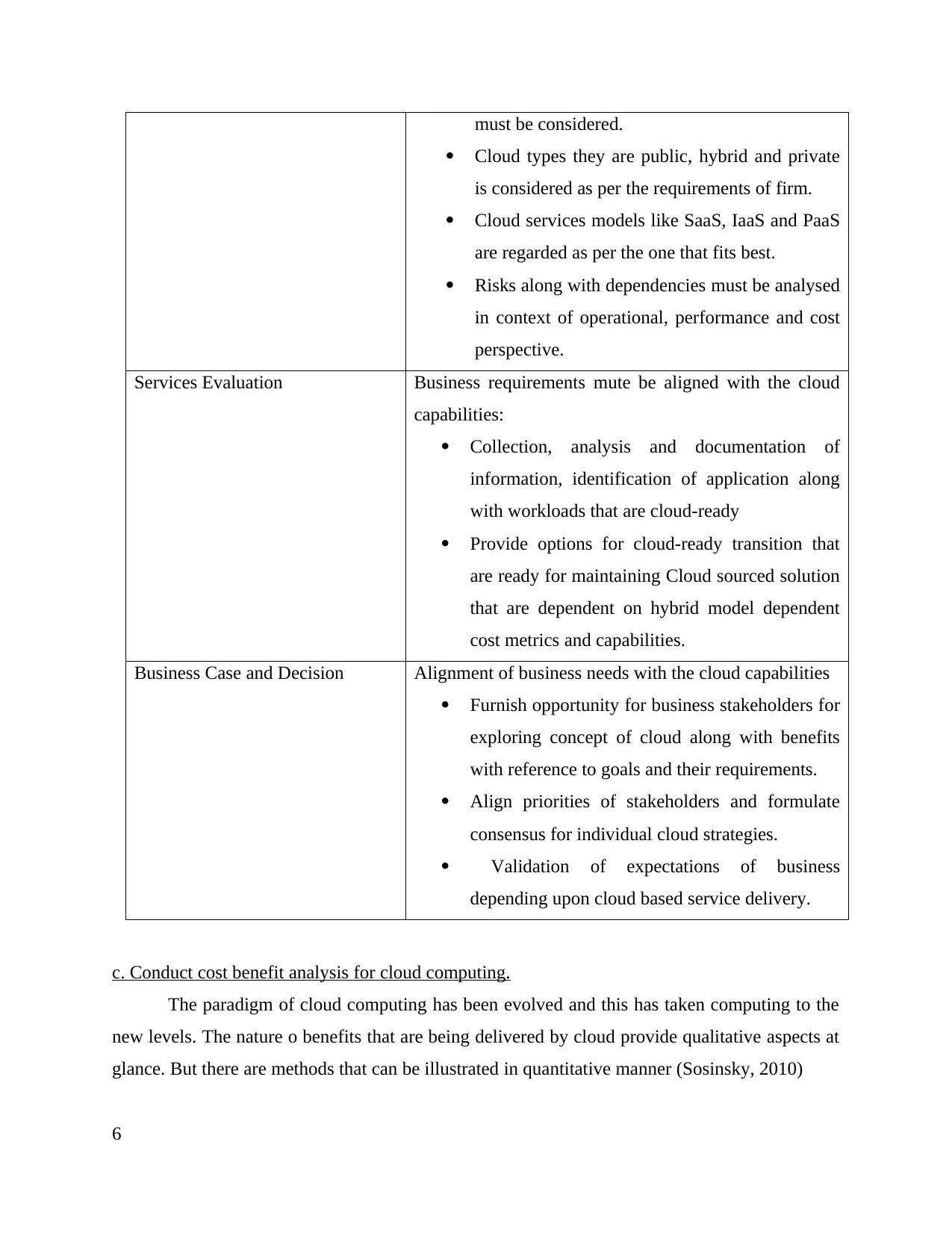
must be considered.
Cloud types they are public, hybrid and private
is considered as per the requirements of firm.
Cloud services models like SaaS, IaaS and PaaS
are regarded as per the one that fits best.
Risks along with dependencies must be analysed
in context of operational, performance and cost
perspective.
Services Evaluation Business requirements mute be aligned with the cloud
capabilities:
Collection, analysis and documentation of
information, identification of application along
with workloads that are cloud-ready
Provide options for cloud-ready transition that
are ready for maintaining Cloud sourced solution
that are dependent on hybrid model dependent
cost metrics and capabilities.
Business Case and Decision Alignment of business needs with the cloud capabilities
Furnish opportunity for business stakeholders for
exploring concept of cloud along with benefits
with reference to goals and their requirements.
Align priorities of stakeholders and formulate
consensus for individual cloud strategies.
Validation of expectations of business
depending upon cloud based service delivery.
c. Conduct cost benefit analysis for cloud computing.
The paradigm of cloud computing has been evolved and this has taken computing to the
new levels. The nature o benefits that are being delivered by cloud provide qualitative aspects at
glance. But there are methods that can be illustrated in quantitative manner (Sosinsky, 2010)
6
Cloud types they are public, hybrid and private
is considered as per the requirements of firm.
Cloud services models like SaaS, IaaS and PaaS
are regarded as per the one that fits best.
Risks along with dependencies must be analysed
in context of operational, performance and cost
perspective.
Services Evaluation Business requirements mute be aligned with the cloud
capabilities:
Collection, analysis and documentation of
information, identification of application along
with workloads that are cloud-ready
Provide options for cloud-ready transition that
are ready for maintaining Cloud sourced solution
that are dependent on hybrid model dependent
cost metrics and capabilities.
Business Case and Decision Alignment of business needs with the cloud capabilities
Furnish opportunity for business stakeholders for
exploring concept of cloud along with benefits
with reference to goals and their requirements.
Align priorities of stakeholders and formulate
consensus for individual cloud strategies.
Validation of expectations of business
depending upon cloud based service delivery.
c. Conduct cost benefit analysis for cloud computing.
The paradigm of cloud computing has been evolved and this has taken computing to the
new levels. The nature o benefits that are being delivered by cloud provide qualitative aspects at
glance. But there are methods that can be illustrated in quantitative manner (Sosinsky, 2010)
6
⊘ This is a preview!⊘
Do you want full access?
Subscribe today to unlock all pages.

Trusted by 1+ million students worldwide
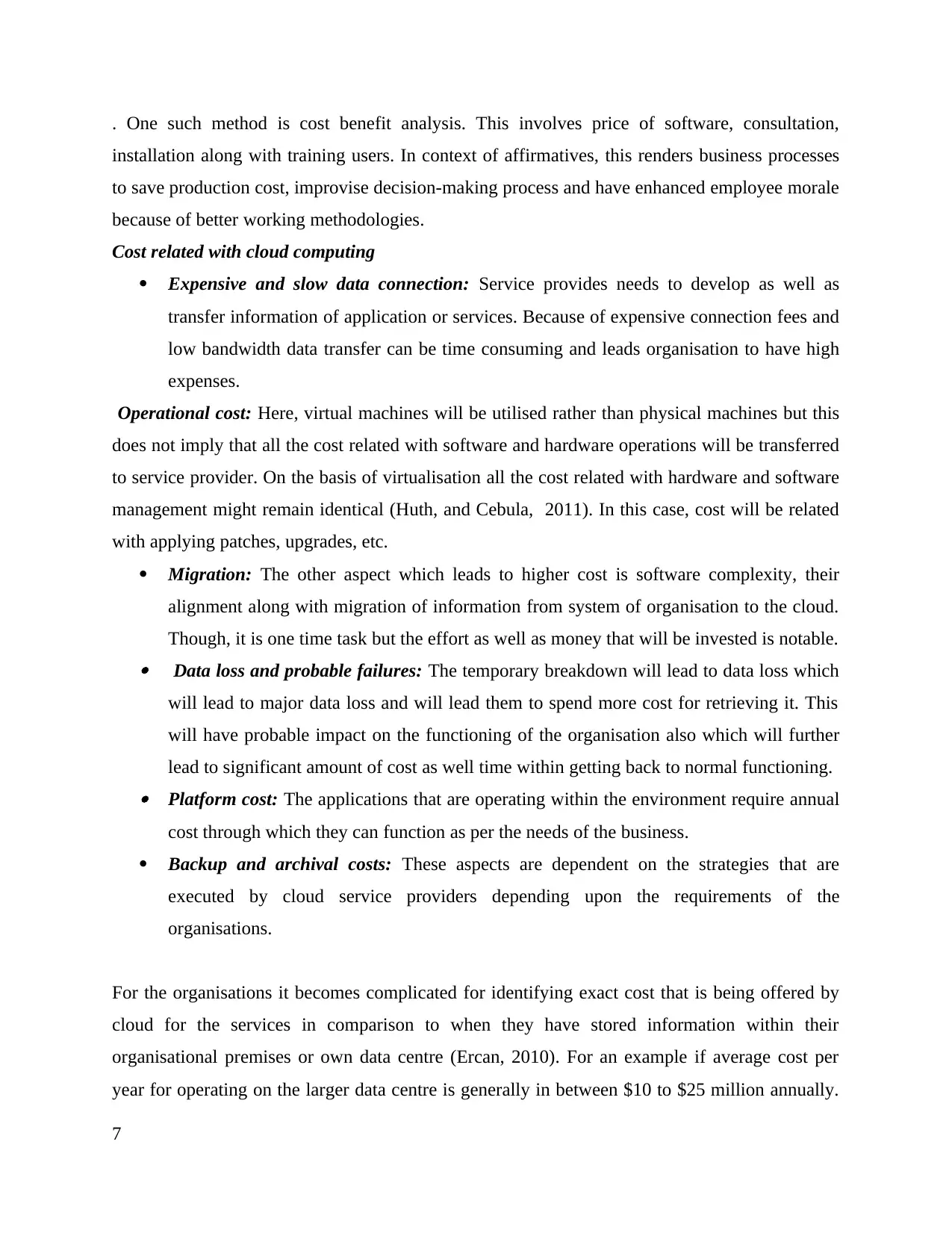
. One such method is cost benefit analysis. This involves price of software, consultation,
installation along with training users. In context of affirmatives, this renders business processes
to save production cost, improvise decision-making process and have enhanced employee morale
because of better working methodologies.
Cost related with cloud computing
Expensive and slow data connection: Service provides needs to develop as well as
transfer information of application or services. Because of expensive connection fees and
low bandwidth data transfer can be time consuming and leads organisation to have high
expenses.
Operational cost: Here, virtual machines will be utilised rather than physical machines but this
does not imply that all the cost related with software and hardware operations will be transferred
to service provider. On the basis of virtualisation all the cost related with hardware and software
management might remain identical (Huth, and Cebula, 2011). In this case, cost will be related
with applying patches, upgrades, etc.
Migration: The other aspect which leads to higher cost is software complexity, their
alignment along with migration of information from system of organisation to the cloud.
Though, it is one time task but the effort as well as money that will be invested is notable. Data loss and probable failures: The temporary breakdown will lead to data loss which
will lead to major data loss and will lead them to spend more cost for retrieving it. This
will have probable impact on the functioning of the organisation also which will further
lead to significant amount of cost as well time within getting back to normal functioning. Platform cost: The applications that are operating within the environment require annual
cost through which they can function as per the needs of the business.
Backup and archival costs: These aspects are dependent on the strategies that are
executed by cloud service providers depending upon the requirements of the
organisations.
For the organisations it becomes complicated for identifying exact cost that is being offered by
cloud for the services in comparison to when they have stored information within their
organisational premises or own data centre (Ercan, 2010). For an example if average cost per
year for operating on the larger data centre is generally in between $10 to $25 million annually.
7
installation along with training users. In context of affirmatives, this renders business processes
to save production cost, improvise decision-making process and have enhanced employee morale
because of better working methodologies.
Cost related with cloud computing
Expensive and slow data connection: Service provides needs to develop as well as
transfer information of application or services. Because of expensive connection fees and
low bandwidth data transfer can be time consuming and leads organisation to have high
expenses.
Operational cost: Here, virtual machines will be utilised rather than physical machines but this
does not imply that all the cost related with software and hardware operations will be transferred
to service provider. On the basis of virtualisation all the cost related with hardware and software
management might remain identical (Huth, and Cebula, 2011). In this case, cost will be related
with applying patches, upgrades, etc.
Migration: The other aspect which leads to higher cost is software complexity, their
alignment along with migration of information from system of organisation to the cloud.
Though, it is one time task but the effort as well as money that will be invested is notable. Data loss and probable failures: The temporary breakdown will lead to data loss which
will lead to major data loss and will lead them to spend more cost for retrieving it. This
will have probable impact on the functioning of the organisation also which will further
lead to significant amount of cost as well time within getting back to normal functioning. Platform cost: The applications that are operating within the environment require annual
cost through which they can function as per the needs of the business.
Backup and archival costs: These aspects are dependent on the strategies that are
executed by cloud service providers depending upon the requirements of the
organisations.
For the organisations it becomes complicated for identifying exact cost that is being offered by
cloud for the services in comparison to when they have stored information within their
organisational premises or own data centre (Ercan, 2010). For an example if average cost per
year for operating on the larger data centre is generally in between $10 to $25 million annually.
7
Paraphrase This Document
Need a fresh take? Get an instant paraphrase of this document with our AI Paraphraser
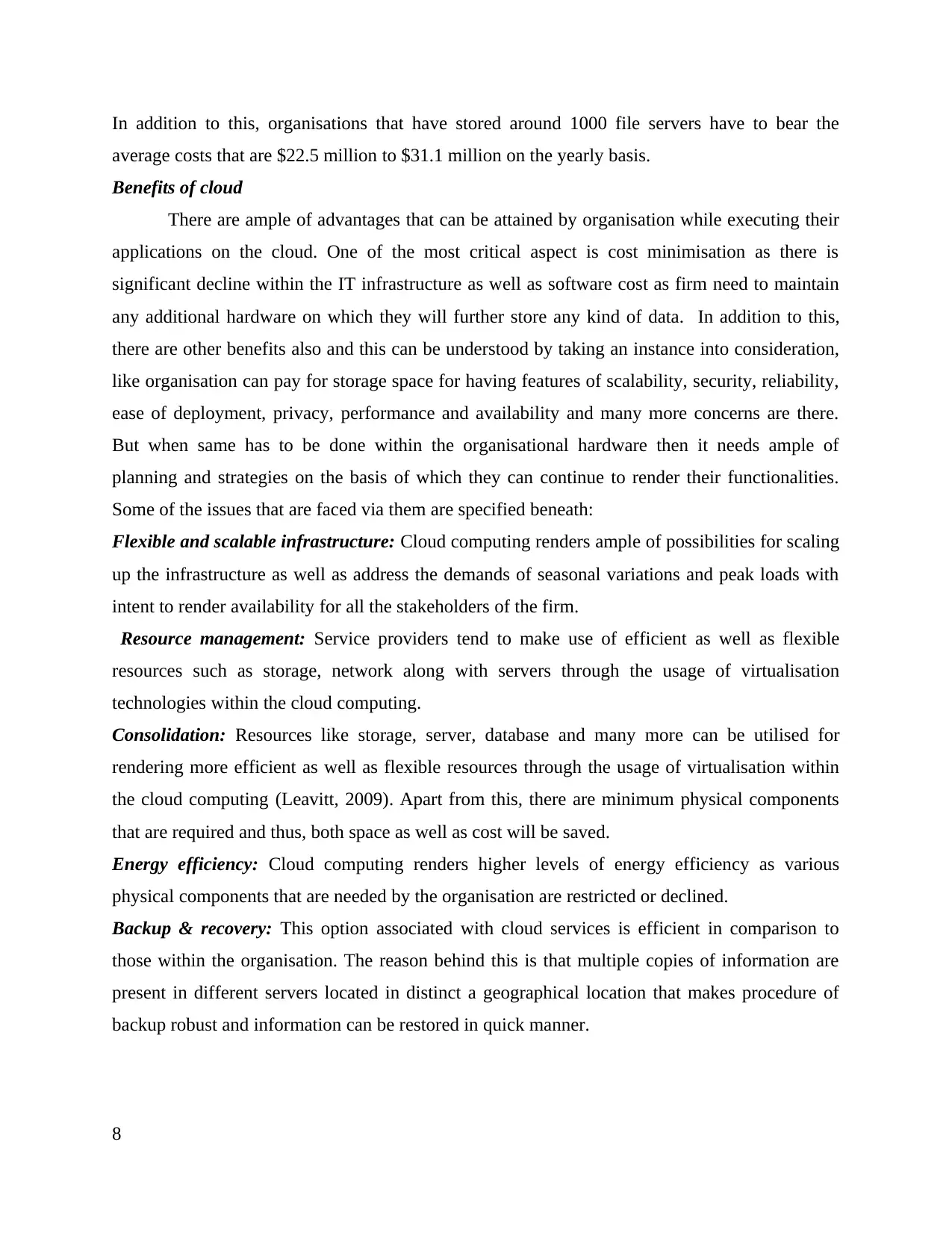
In addition to this, organisations that have stored around 1000 file servers have to bear the
average costs that are $22.5 million to $31.1 million on the yearly basis.
Benefits of cloud
There are ample of advantages that can be attained by organisation while executing their
applications on the cloud. One of the most critical aspect is cost minimisation as there is
significant decline within the IT infrastructure as well as software cost as firm need to maintain
any additional hardware on which they will further store any kind of data. In addition to this,
there are other benefits also and this can be understood by taking an instance into consideration,
like organisation can pay for storage space for having features of scalability, security, reliability,
ease of deployment, privacy, performance and availability and many more concerns are there.
But when same has to be done within the organisational hardware then it needs ample of
planning and strategies on the basis of which they can continue to render their functionalities.
Some of the issues that are faced via them are specified beneath:
Flexible and scalable infrastructure: Cloud computing renders ample of possibilities for scaling
up the infrastructure as well as address the demands of seasonal variations and peak loads with
intent to render availability for all the stakeholders of the firm.
Resource management: Service providers tend to make use of efficient as well as flexible
resources such as storage, network along with servers through the usage of virtualisation
technologies within the cloud computing.
Consolidation: Resources like storage, server, database and many more can be utilised for
rendering more efficient as well as flexible resources through the usage of virtualisation within
the cloud computing (Leavitt, 2009). Apart from this, there are minimum physical components
that are required and thus, both space as well as cost will be saved.
Energy efficiency: Cloud computing renders higher levels of energy efficiency as various
physical components that are needed by the organisation are restricted or declined.
Backup & recovery: This option associated with cloud services is efficient in comparison to
those within the organisation. The reason behind this is that multiple copies of information are
present in different servers located in distinct a geographical location that makes procedure of
backup robust and information can be restored in quick manner.
8
average costs that are $22.5 million to $31.1 million on the yearly basis.
Benefits of cloud
There are ample of advantages that can be attained by organisation while executing their
applications on the cloud. One of the most critical aspect is cost minimisation as there is
significant decline within the IT infrastructure as well as software cost as firm need to maintain
any additional hardware on which they will further store any kind of data. In addition to this,
there are other benefits also and this can be understood by taking an instance into consideration,
like organisation can pay for storage space for having features of scalability, security, reliability,
ease of deployment, privacy, performance and availability and many more concerns are there.
But when same has to be done within the organisational hardware then it needs ample of
planning and strategies on the basis of which they can continue to render their functionalities.
Some of the issues that are faced via them are specified beneath:
Flexible and scalable infrastructure: Cloud computing renders ample of possibilities for scaling
up the infrastructure as well as address the demands of seasonal variations and peak loads with
intent to render availability for all the stakeholders of the firm.
Resource management: Service providers tend to make use of efficient as well as flexible
resources such as storage, network along with servers through the usage of virtualisation
technologies within the cloud computing.
Consolidation: Resources like storage, server, database and many more can be utilised for
rendering more efficient as well as flexible resources through the usage of virtualisation within
the cloud computing (Leavitt, 2009). Apart from this, there are minimum physical components
that are required and thus, both space as well as cost will be saved.
Energy efficiency: Cloud computing renders higher levels of energy efficiency as various
physical components that are needed by the organisation are restricted or declined.
Backup & recovery: This option associated with cloud services is efficient in comparison to
those within the organisation. The reason behind this is that multiple copies of information are
present in different servers located in distinct a geographical location that makes procedure of
backup robust and information can be restored in quick manner.
8
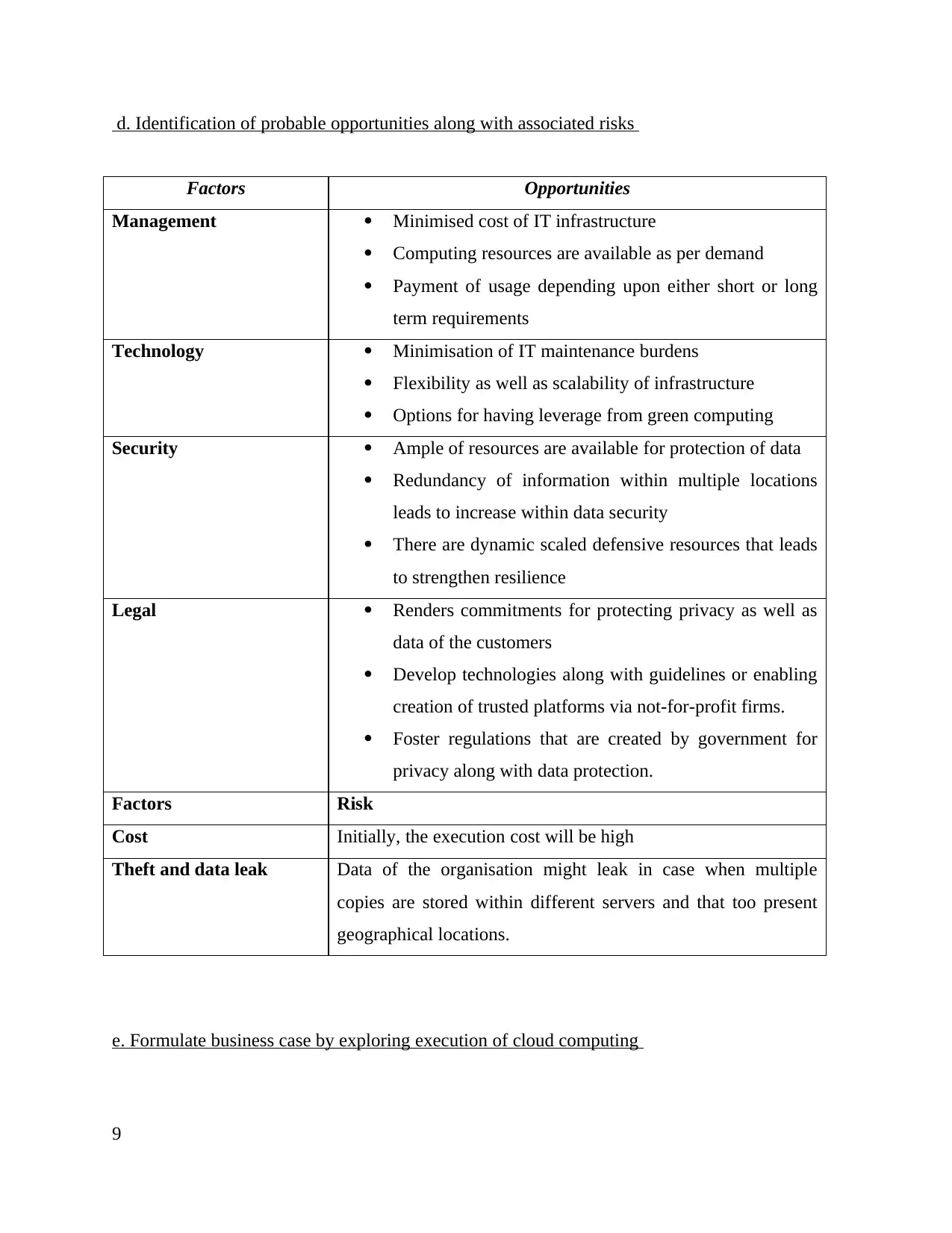
d. Identification of probable opportunities along with associated risks
Factors Opportunities
Management Minimised cost of IT infrastructure
Computing resources are available as per demand
Payment of usage depending upon either short or long
term requirements
Technology Minimisation of IT maintenance burdens
Flexibility as well as scalability of infrastructure
Options for having leverage from green computing
Security Ample of resources are available for protection of data
Redundancy of information within multiple locations
leads to increase within data security
There are dynamic scaled defensive resources that leads
to strengthen resilience
Legal Renders commitments for protecting privacy as well as
data of the customers
Develop technologies along with guidelines or enabling
creation of trusted platforms via not-for-profit firms.
Foster regulations that are created by government for
privacy along with data protection.
Factors Risk
Cost Initially, the execution cost will be high
Theft and data leak Data of the organisation might leak in case when multiple
copies are stored within different servers and that too present
geographical locations.
e. Formulate business case by exploring execution of cloud computing
9
Factors Opportunities
Management Minimised cost of IT infrastructure
Computing resources are available as per demand
Payment of usage depending upon either short or long
term requirements
Technology Minimisation of IT maintenance burdens
Flexibility as well as scalability of infrastructure
Options for having leverage from green computing
Security Ample of resources are available for protection of data
Redundancy of information within multiple locations
leads to increase within data security
There are dynamic scaled defensive resources that leads
to strengthen resilience
Legal Renders commitments for protecting privacy as well as
data of the customers
Develop technologies along with guidelines or enabling
creation of trusted platforms via not-for-profit firms.
Foster regulations that are created by government for
privacy along with data protection.
Factors Risk
Cost Initially, the execution cost will be high
Theft and data leak Data of the organisation might leak in case when multiple
copies are stored within different servers and that too present
geographical locations.
e. Formulate business case by exploring execution of cloud computing
9
⊘ This is a preview!⊘
Do you want full access?
Subscribe today to unlock all pages.

Trusted by 1+ million students worldwide
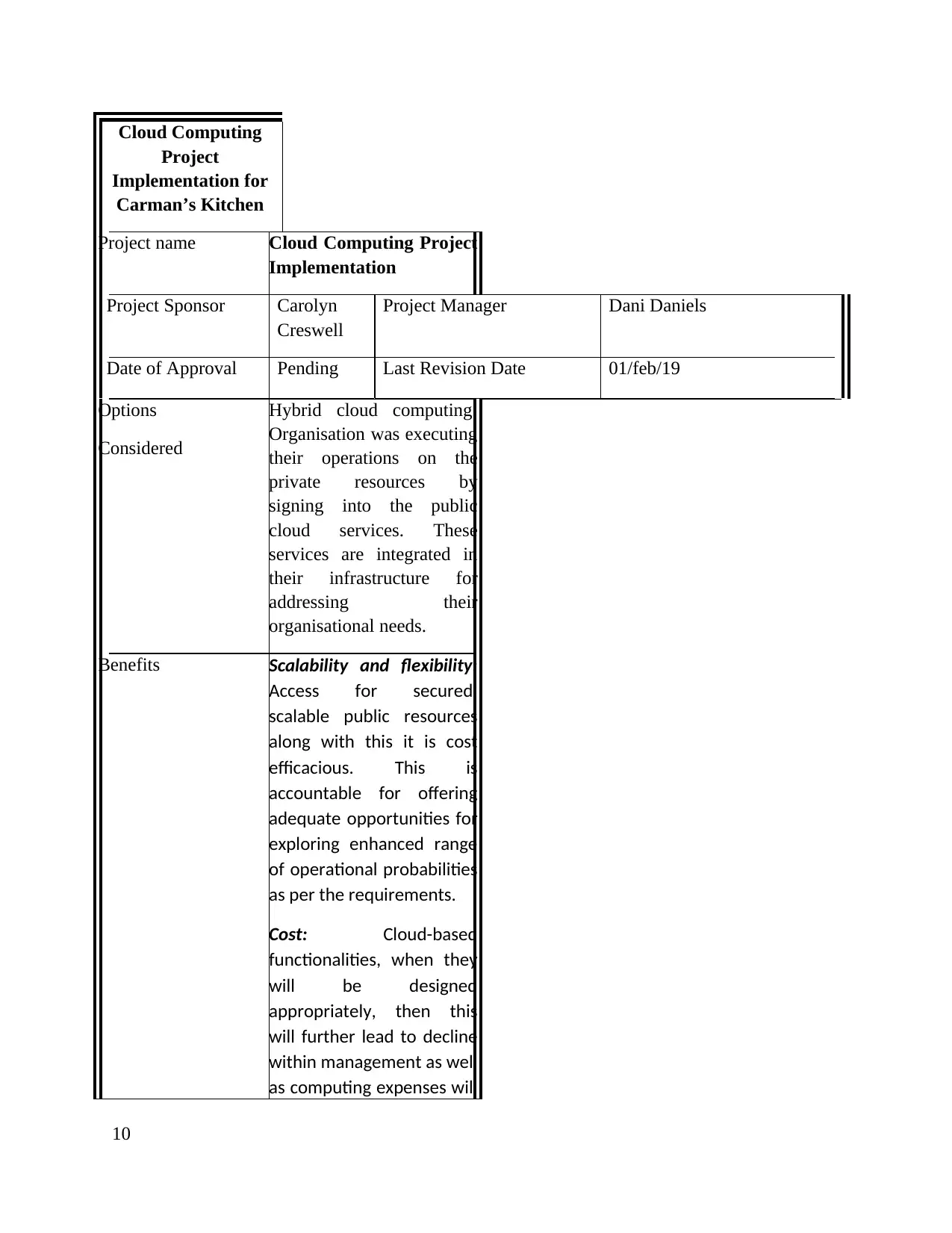
Cloud Computing
Project
Implementation for
Carman’s Kitchen
Project name Cloud Computing Project
Implementation
Project Sponsor Carolyn
Creswell
Project Manager Dani Daniels
Date of Approval Pending Last Revision Date 01/feb/19
Options
Considered
Hybrid cloud computing:
Organisation was executing
their operations on the
private resources by
signing into the public
cloud services. These
services are integrated in
their infrastructure for
addressing their
organisational needs.
Benefits Scalability and flexibility:
Access for secured,
scalable public resources
along with this it is cost
efficacious. This is
accountable for offering
adequate opportunities for
exploring enhanced range
of operational probabilities
as per the requirements.
Cost: Cloud-based
functionalities, when they
will be designed
appropriately, then this
will further lead to decline
within management as well
as computing expenses will
10
Project
Implementation for
Carman’s Kitchen
Project name Cloud Computing Project
Implementation
Project Sponsor Carolyn
Creswell
Project Manager Dani Daniels
Date of Approval Pending Last Revision Date 01/feb/19
Options
Considered
Hybrid cloud computing:
Organisation was executing
their operations on the
private resources by
signing into the public
cloud services. These
services are integrated in
their infrastructure for
addressing their
organisational needs.
Benefits Scalability and flexibility:
Access for secured,
scalable public resources
along with this it is cost
efficacious. This is
accountable for offering
adequate opportunities for
exploring enhanced range
of operational probabilities
as per the requirements.
Cost: Cloud-based
functionalities, when they
will be designed
appropriately, then this
will further lead to decline
within management as well
as computing expenses will
10
Paraphrase This Document
Need a fresh take? Get an instant paraphrase of this document with our AI Paraphraser
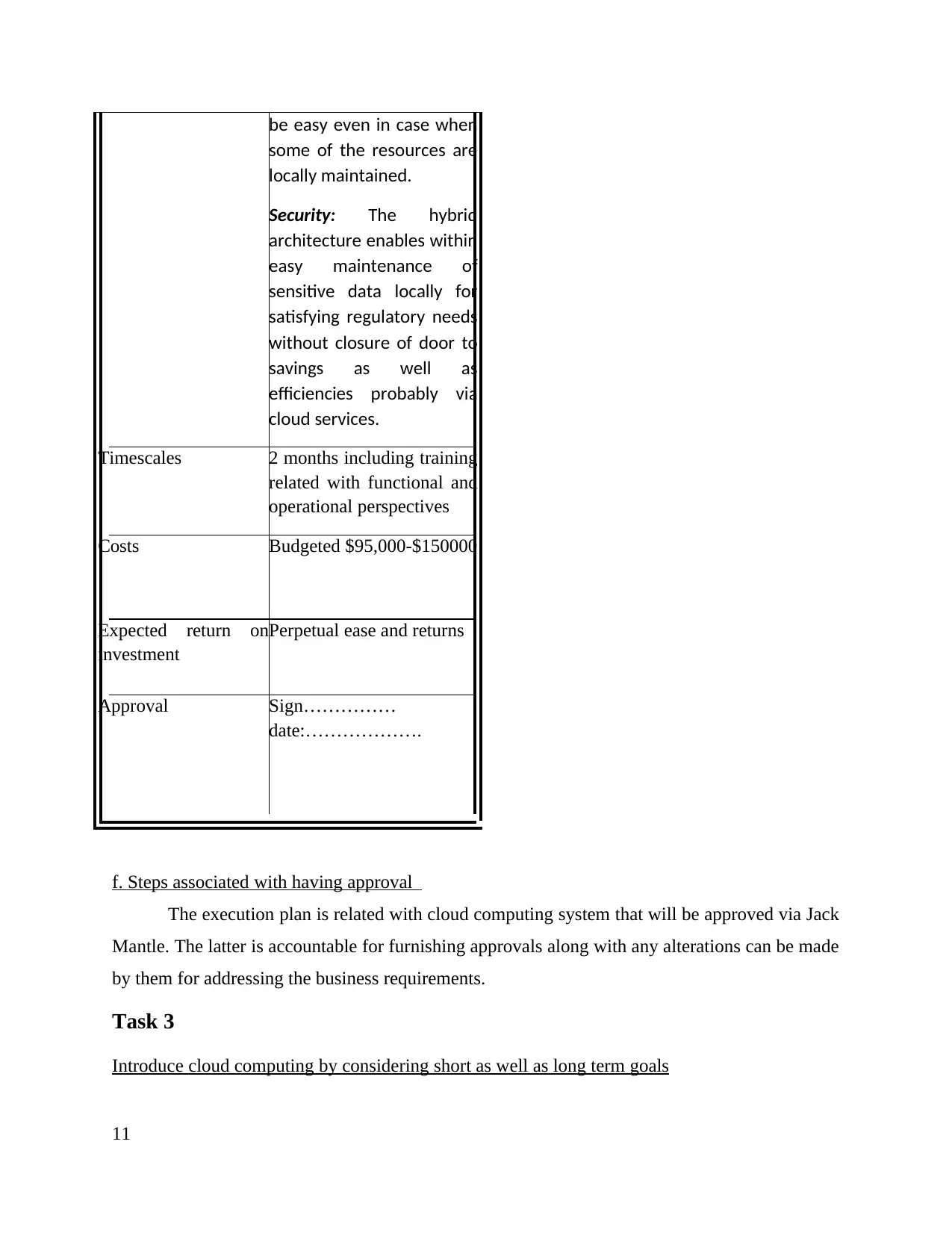
be easy even in case when
some of the resources are
locally maintained.
Security: The hybrid
architecture enables within
easy maintenance of
sensitive data locally for
satisfying regulatory needs
without closure of door to
savings as well as
efficiencies probably via
cloud services.
Timescales 2 months including training
related with functional and
operational perspectives
Costs Budgeted $95,000-$150000
Expected return on
investment
Perpetual ease and returns
Approval Sign……………
date:……………….
f. Steps associated with having approval
The execution plan is related with cloud computing system that will be approved via Jack
Mantle. The latter is accountable for furnishing approvals along with any alterations can be made
by them for addressing the business requirements.
Task 3
Introduce cloud computing by considering short as well as long term goals
11
some of the resources are
locally maintained.
Security: The hybrid
architecture enables within
easy maintenance of
sensitive data locally for
satisfying regulatory needs
without closure of door to
savings as well as
efficiencies probably via
cloud services.
Timescales 2 months including training
related with functional and
operational perspectives
Costs Budgeted $95,000-$150000
Expected return on
investment
Perpetual ease and returns
Approval Sign……………
date:……………….
f. Steps associated with having approval
The execution plan is related with cloud computing system that will be approved via Jack
Mantle. The latter is accountable for furnishing approvals along with any alterations can be made
by them for addressing the business requirements.
Task 3
Introduce cloud computing by considering short as well as long term goals
11
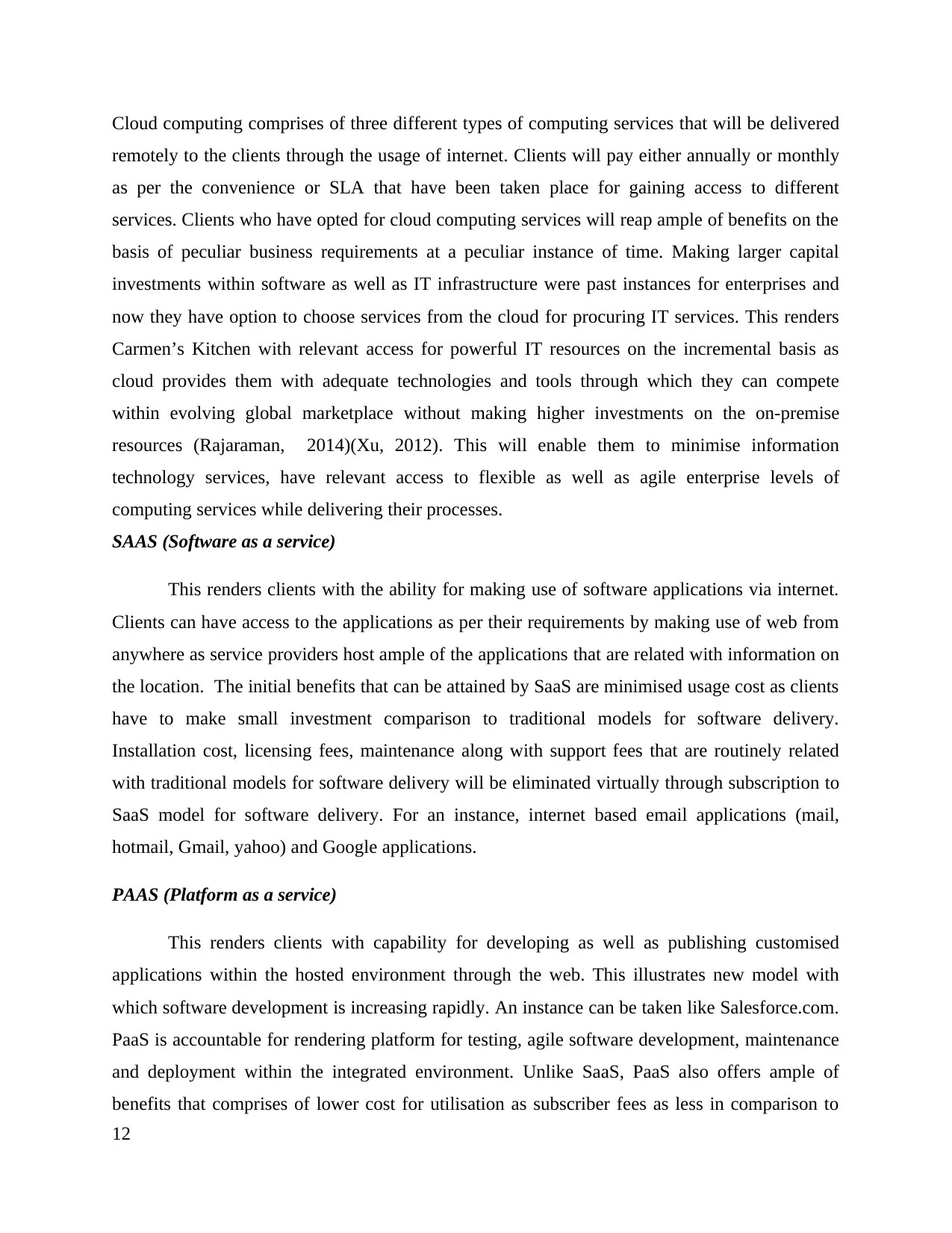
Cloud computing comprises of three different types of computing services that will be delivered
remotely to the clients through the usage of internet. Clients will pay either annually or monthly
as per the convenience or SLA that have been taken place for gaining access to different
services. Clients who have opted for cloud computing services will reap ample of benefits on the
basis of peculiar business requirements at a peculiar instance of time. Making larger capital
investments within software as well as IT infrastructure were past instances for enterprises and
now they have option to choose services from the cloud for procuring IT services. This renders
Carmen’s Kitchen with relevant access for powerful IT resources on the incremental basis as
cloud provides them with adequate technologies and tools through which they can compete
within evolving global marketplace without making higher investments on the on-premise
resources (Rajaraman, 2014)(Xu, 2012). This will enable them to minimise information
technology services, have relevant access to flexible as well as agile enterprise levels of
computing services while delivering their processes.
SAAS (Software as a service)
This renders clients with the ability for making use of software applications via internet.
Clients can have access to the applications as per their requirements by making use of web from
anywhere as service providers host ample of the applications that are related with information on
the location. The initial benefits that can be attained by SaaS are minimised usage cost as clients
have to make small investment comparison to traditional models for software delivery.
Installation cost, licensing fees, maintenance along with support fees that are routinely related
with traditional models for software delivery will be eliminated virtually through subscription to
SaaS model for software delivery. For an instance, internet based email applications (mail,
hotmail, Gmail, yahoo) and Google applications.
PAAS (Platform as a service)
This renders clients with capability for developing as well as publishing customised
applications within the hosted environment through the web. This illustrates new model with
which software development is increasing rapidly. An instance can be taken like Salesforce.com.
PaaS is accountable for rendering platform for testing, agile software development, maintenance
and deployment within the integrated environment. Unlike SaaS, PaaS also offers ample of
benefits that comprises of lower cost for utilisation as subscriber fees as less in comparison to
12
remotely to the clients through the usage of internet. Clients will pay either annually or monthly
as per the convenience or SLA that have been taken place for gaining access to different
services. Clients who have opted for cloud computing services will reap ample of benefits on the
basis of peculiar business requirements at a peculiar instance of time. Making larger capital
investments within software as well as IT infrastructure were past instances for enterprises and
now they have option to choose services from the cloud for procuring IT services. This renders
Carmen’s Kitchen with relevant access for powerful IT resources on the incremental basis as
cloud provides them with adequate technologies and tools through which they can compete
within evolving global marketplace without making higher investments on the on-premise
resources (Rajaraman, 2014)(Xu, 2012). This will enable them to minimise information
technology services, have relevant access to flexible as well as agile enterprise levels of
computing services while delivering their processes.
SAAS (Software as a service)
This renders clients with the ability for making use of software applications via internet.
Clients can have access to the applications as per their requirements by making use of web from
anywhere as service providers host ample of the applications that are related with information on
the location. The initial benefits that can be attained by SaaS are minimised usage cost as clients
have to make small investment comparison to traditional models for software delivery.
Installation cost, licensing fees, maintenance along with support fees that are routinely related
with traditional models for software delivery will be eliminated virtually through subscription to
SaaS model for software delivery. For an instance, internet based email applications (mail,
hotmail, Gmail, yahoo) and Google applications.
PAAS (Platform as a service)
This renders clients with capability for developing as well as publishing customised
applications within the hosted environment through the web. This illustrates new model with
which software development is increasing rapidly. An instance can be taken like Salesforce.com.
PaaS is accountable for rendering platform for testing, agile software development, maintenance
and deployment within the integrated environment. Unlike SaaS, PaaS also offers ample of
benefits that comprises of lower cost for utilisation as subscriber fees as less in comparison to
12
⊘ This is a preview!⊘
Do you want full access?
Subscribe today to unlock all pages.

Trusted by 1+ million students worldwide
1 out of 17
Related Documents
Your All-in-One AI-Powered Toolkit for Academic Success.
+13062052269
info@desklib.com
Available 24*7 on WhatsApp / Email
![[object Object]](/_next/static/media/star-bottom.7253800d.svg)
Unlock your academic potential
Copyright © 2020–2025 A2Z Services. All Rights Reserved. Developed and managed by ZUCOL.





